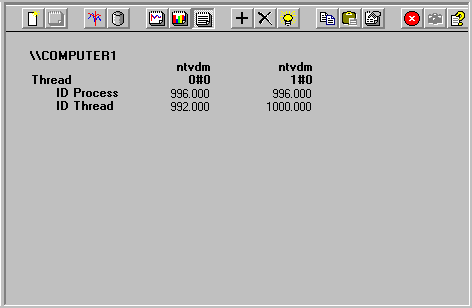Monitoring 16-bit Windows Applications
In Windows 2000, by default, all active 16-bit Windows applications run as separate threads in a single multithreaded process called NT Virtual DOS Machine (NTVDM). The NTVDM process simulates a 16-bit Windows environment complete with all of the DLLs called by 16-bit Windows applications.
This configuration poses two challenges for running 16-bit applications:
- It prevents 16-bit applications from running simultaneously, which might impede their performance.
- It makes monitoring a bit trickier because 16-bit applications do not appear by name in the Add Counters dialog box for the performance tools; instead, they appear as undistinguishable NTVDM processes.
As a result, Windows 2000 includes an option to run a 16-bit application in its own separate NTVDM process with its own address space. You can monitor 16-bit Windows applications by identifying them by their thread identifier (ID) while they are running, or by running each application in a separate address space.
In addition to the 16-bit applications, each NTVDM process includes a heartbeat thread that interrupts every 55 milliseconds to simulate a timer interrupt, and the Wowexec.exe thread, which helps to create 16-bit tasks and to handle the delivery of the 16-bit interrupt. This thread supports 16-bit Windows applications in a 32-bit Windows environment. The WOW subsystem provides a virtual DOS machine where all Win16 applications run. You will see the heartbeat and Wowexec threads when monitoring 16-bit applications.
Only one 16-bit Windows application thread in an NTVDM can run at one time and, if an application thread is preempted, the NTVDM always resumes with the same thread. This limits the performance of multiple 16-bit applications running in the same NTVDM process, although this limitation becomes an issue only when the processor is very busy.
Although System Monitor can monitor 16-bit applications in Windows 2000 because they run in the same process, the trick to monitoring more than one 16-bit application is to distinguish among the threads of the NTVDM process.
To monitor one 16-bit application, select the NTVDM process in System Monitor. (Other performance tools used to monitor processes can be used for monitoring the NTVDM process. For more information, see "Analyzing Processor Activity" in this book.) If you have multiple 16-bit processes running in NTVDM, you can distinguish them by their thread identifiers (IDs). You might have to start and stop the 16-bit process to determine which ID is associated with which 16-bit process.

Enlarge figure
Figure 5.13 NTVDM Threads in System Monitor
Figure 5.13 shows a System Monitor report on a single NTVDM process. The ID Process and ID Thread counters are included to help you distinguish among the threads. One of the threads is the heartbeat thread, one is the Wowexec thread, and one is a 16-bit application.
System Monitor identifies threads by the process name and a thread number. The thread numbers are ordinal numbers (beginning with 0) that represent the order in which the threads started. The thread number of a running thread changes when a thread with a lower number stops, and all threads with higher numbers move up in order to close the gap. For example, if thread 1 stopped, thread 2 becomes thread 1. Therefore, thread numbers are not reliable indicators of thread identity.
Instead, with System Monitor you can track processes and threads using the process IDs and thread IDs. The process ID identifies the process in which the thread runs. The thread ID identifies the thread. Unlike the thread number, which can change over the time the thread runs, the system assigns the thread ID when the thread starts and retains it until the thread stops.

Enlarge figure
Figure 5.14 MyApp, Wowexec, and Ntvdm on the Task Manager Process Tab
As shown in Figure 5.14, Task Manager makes it easy to identify 16-bit applications because it displays the names of the executable files indented below the NTVDM process name. To monitor 16-bit processes in Task Manager, click the Processes tab, and on the Options menu, click Show 16-bit Tasks.
In this example, you can see the Wowexec (Windows on Windows) and the MyApp threads. The heartbeat thread is not an executable and does not appear as a process in Task Manager. However, the Thread Count column on the far right shows that all threads are running in the NTVDM process.
© 1985-2000 Microsoft Corporation. All rights reserved.
EAN: N/A
Pages: 404